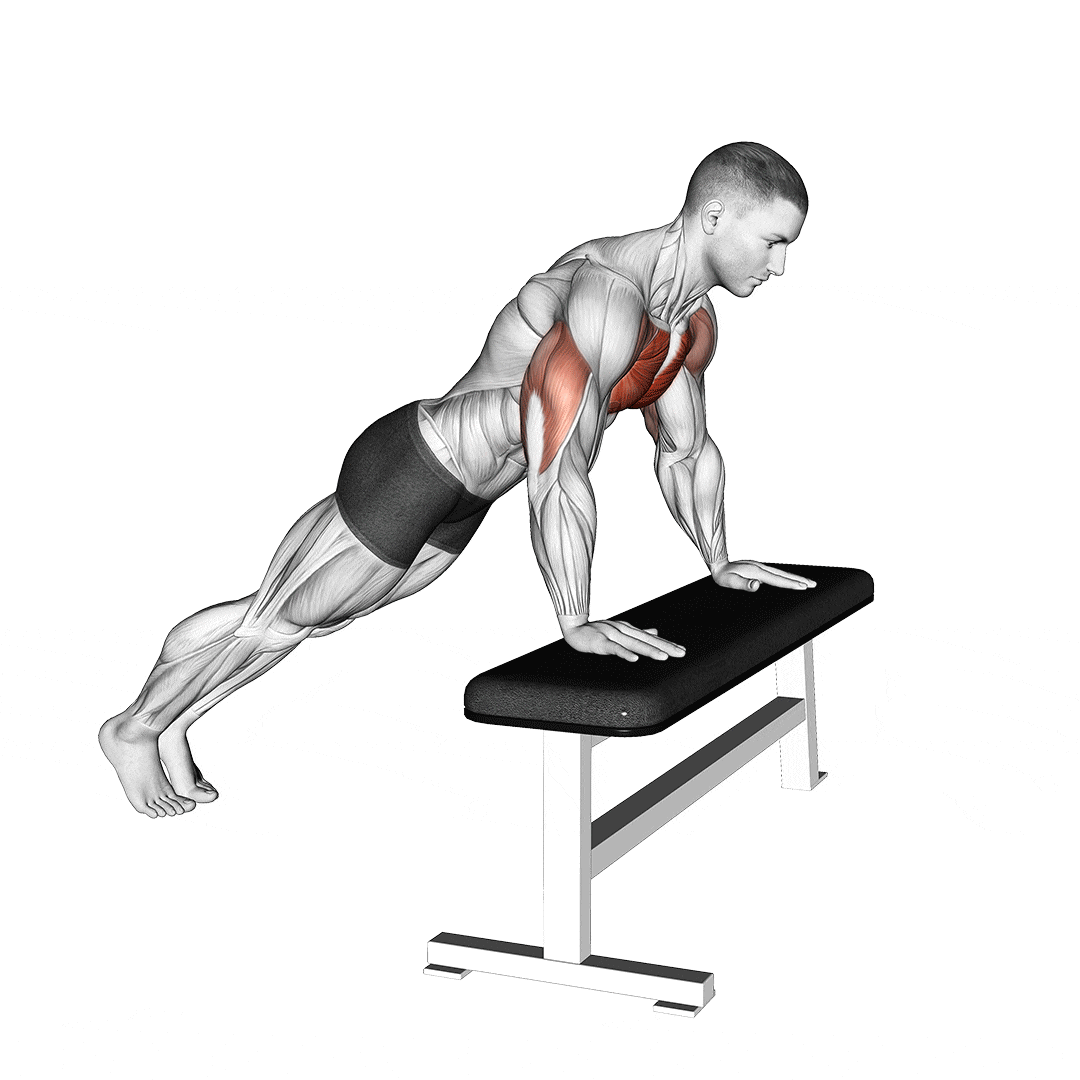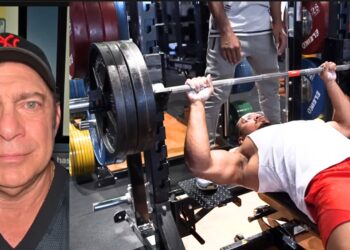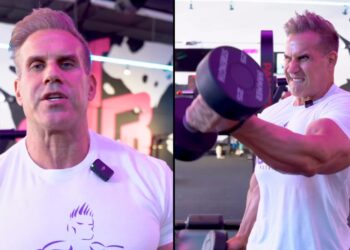As well as being a 30-year veteran personal trainer, I’m also a former powerlifter. As such, I’ve spent a lot of my professional and athletic career doing bench presses. While I’ve never been a great bencher, I acknowledge that it’s one of the best exercises for building upper body size and strength.
However, while the bench press deserves its widespread popularity, it’s not the only way to build your chest, shoulders, and triceps.
In fact, there may be times and situations where bench presses are impractical or unsafe.
Thankfully, there are plenty of useful bench press alternatives, including the humble push-up. And before you tell me that push-ups can’t possibly compare to bench presses, it’s worth noting that research says these very different exercises are similarly effective (1, 2).
So, no bench press? No problem! Build your upper body with push-ups.
In this article, I explore the incline push-up, which is one of the most accessible of all the push-up variations and a great bench press alternative.
Level Up Your Fitness: Join our 💪 strong community in Fitness Volt Newsletter. Get daily inspiration, expert-backed workouts, nutrition tips, the latest in strength sports, and the support you need to reach your goals. Subscribe for free!
Why Do Incline Push-Ups Instead of Bench Presses?
There is no denying the popularity and effectiveness of bench presses. However, there may be times and situations where you need an alternative, such as incline push-ups.
Why? When?
Here’s a list of reasons why incline push-ups could be a viable alternative to bench presses.
Lack of Equipment
Training in a gym means easy access to barbells and benches. However, if you work out at home, you may not have the equipment you need to do bench presses. The same is true if you prefer outdoor workouts or are a frequent traveler and stay in hotels without gyms.
Incline push-ups are an excellent equipment-free option to train your pecs anywhere and anytime.
Training Alone
Studies indicate that training near to failure is an integral part of building muscle and strength (3).
However, bench pressing to failure can be risky, as there is a danger of getting pinned under a heavy barbell. Needless to say, this could cause severe injury. As such, it’s generally best to bench press with a spotter or use a power rack. Incline push-ups are much safer for solo exercisers, and you can train to failure in relative safety.
Shoulder Problems
While the bench press is an effective muscle and strength builder, it can be hard on your joints. In my experience, exercisers who bench press regularly also tend to experience chronic shoulder pain. Bench pressing can also cause pec tears.
Incline push-ups are generally safer than bench presses and less likely to cause shoulder problems and other injuries.
Beginner Status
Beginners sometimes struggle to perform bench presses correctly. Despite being a seemingly straightforward exercise, there is a lot going on during the bench press, and using the correct technique is critical. In addition, even an empty barbell can be too heavy, typically weighing 45 pounds/20kg when empty.
Consequently, the bench press may be impractical for some people. In contrast, push-ups are easier – both in terms of load and technique – making them far more accessible.
Variety
We have a saying in the fitness industry: if you always do what you have always done, you’ll always get what you have always got. In other words, if you want to change your body, you also need to change your workouts from time to time.
Incline push-ups are just one of the many alternatives to the bench press. As such, you can use them to add variety to your upper-body workouts. Periodically changing your exercises could help you steer clear of training ruts and progress plateaus.
Build Strength for Regular Push-Ups
Regular push-ups put 50-60% of your weight on your hands. This is a significant load for heavier exercisers and beginners. Incline push-ups are considerably more manageable, making them a good option for anyone not yet strong enough to perform full push-ups.
Working from a high to a lower platform is an excellent way to build strength and work up to doing regular push-ups.
For Warm-Ups
Good workouts start with a thorough warm-up. Jumping straight into heavy loads puts a lot of stress on your muscles, tendons, and joints and could lead to injury. Incline push-ups are an effective way to prepare your muscles and joints for the demands of an intense upper-body workout.
While there is no guarantee that warming up will prevent all injuries, it should lower your risk while maximizing muscle engagement for a more productive workout.
Emphasize Your Lower Chest
Incline push-ups are a compound exercise utilizing several muscles and multiple joints, namely the pectoralis major (pecs), deltoids (delts), and triceps. Your core and even your legs also get in on the action.
However, the angle of your arms means you’ll be pushing outward and downward, which somewhat emphasizes the lower fibers of the pecs. Consequently, if you want to shape and develop your lower chest, incline push-ups will help.
Level Up Your Fitness: Join our 💪 strong community in Fitness Volt Newsletter. Get daily inspiration, expert-backed workouts, nutrition tips, the latest in strength sports, and the support you need to reach your goals. Subscribe for free!
A More Functional Exercise
While the term “functional exercise” is open to interpretation, it usually means an exercise that carries over well to activities outside of the gym. The bench press is quite non-functional because it involves lifting a weight while lying on your back. That’s something most people seldom do in real life.
In contrast, incline push-ups are arguably more functional because your feet remain planted on the floor, you must brace your core to stabilize your spine, and you use your arms to lift your body. This will potentially carry over better to non-gym activities.
While incline push-ups are a mostly beneficial exercise, there are also a couple of drawbacks to consider:
Limited Overload
Incline push-ups involve lifting less weight than regular push-ups. As such, they aren’t as effective for building strength. However, provided you work to failure, you can still use incline push-ups to build muscle, even if you are an advanced exerciser (4).
You’ll Need A Suitable Platform
It’s not always possible to find a suitable platform for incline push-ups. However, you can replicate this exercise without equipment by bending your legs and doing push-ups on your knees. This takes some weight off your arms but mirrors the body angle of incline push-ups.
How to Do Incline Push-Ups
Now that you have some compelling reasons to do incline push-ups, get the most from this exercise by doing them correctly! Follow these steps for a safer, more effective workout.
- Stand facing a sturdy platform, such as a plyo box or workout bench.
- Place your palms on the nearside edge, hands about shoulder-width apart.
- Walk your feet back until your legs and body are straight.
- Brace your core and tense your legs to keep your body rigid.
- Inhale, bend your arms, and lower your sternum to the platform.
- Exhale and extend your arms until your elbows are straight but not locked.
- Continue for the prescribed number of reps.
Pro tips:
- Move your hands further apart to increase pec engagement.
- The higher the platform and the more inclined your body is, the easier this exercise becomes.
- Take 2-4 seconds to lower your chest to the platform and then push up explosively for maximal muscle activation.
- Make this exercise harder by wearing a weighted vest.
- You can also do this exercise with your hands on a table, countertop, or the bar of a Smith machine.
7 Incline Push-Up Alternatives
Incline push-ups are an effective chest, shoulder, and triceps exercise. But that doesn’t mean you need to do them all the time. Here are seven alternatives you can use to keep your workouts productive and interesting:
1. Regular Push-Ups
The next logical step after mastering incline push-ups is doing push-ups with your hands on the floor, i.e., regular push-ups. This puts more weight on your hands and will provide a more significant challenge for your muscles.
Steps:
- Squat down and place your hands flat on the floor, roughly shoulder-width apart.
- Walk your feet out and back so your body is straight. Brace your core.
- Bend your arms and lower your chest to within an inch of the ground.
- Extend your arms and return to the starting position.
2. Decline Barbell Bench Press
Despite looking completely different, the incline push-up and decline bench press work many of the same muscles. However, using a barbell means you have more flexibility over how much weight you use.
Steps:
- Lie on the decline bench with your legs anchored and your eyes below the bar.
- Hold the bar with an overhand, slightly wider than shoulder width grip and unrack it.
- Bend your arms and lower the bar to your sternum.
- Press the bar back up and repeat.
- Rerack the bar at the end of your set.
- You can also do this exercise using a Smith machine and with dumbbells.
3. Decline Cable Chest Press
Freeweights are great, but they can also be dangerous. A dropped barbell or dumbbell can cause severe injury. In addition, they don’t tend to keep your muscles under constant tension, which may hurt your gains. Cable exercises fix both these problems, and decline cable chest presses are a very effective lower pec exercise.
Steps:
- Attach D-shaped handles to a dual cable machine. Set the handles to about shoulder height.
- Hold a handle in each hand in front of your shoulders. Adopt a split stance for stability and brace your core.
- Extend your arms and push the handles forward and down in a decline motion.
- Bring the handles back to your shoulders and repeat.
- You can also do this exercise using resistance bands
4. Chest Dips
Dips are often seen as a triceps exercise, but they’re actually an excellent lower chest builder. You’ll need to be pretty strong to perform this exercise. Still, if you have mastered incline and regular push-ups, it’s the next logical step in bodyweight training.
Steps:
- Using slightly wider than shoulder-width parallel bars, support your weight on straight arms, palms facing inward. Push your shoulders down and back and lift your chest.
- Leaning forward slightly, bend your arms and lower your shoulders down toward your hands. Descend as far as your flexibility and joint health allow.
- Push yourself back up and repeat.
5. Decline Dumbbell Fly
The preceding four lower chest builders have been compound exercises. This means they involved two or more joints and multiple additional muscles. The next three movements are isolation exercises, meaning fewer muscles and only one joint working at a time. These exercises target your lower pecs more precisely.
Steps:
- Hold a dumbbell in each hand and sit on a declined bench. Anchor your legs.
- Lean back and hold the dumbbells over your chest, palms facing inward, and elbows slightly bent.
- Open your arms and lower the dumbbells out and down until you feel a stretch in your pecs, and your arms form a T-shape.
- Squeeze the dumbbells back up and together.
- Continue for the prescribed number of reps.
6. High to Low Cable Crossover
Dumbbell decline flies are effective, but there is very little stress on your pecs at the start/end of each rep. Using cables keeps your muscles under constant tension, which may enhance your gains. Go slow and smooth to maximize the effectiveness of this exercise.
Steps:
- Attach D-shaped handles to a dual cable machine. Set the handles to about shoulder height. Take a handle in each hand and extend your arms to the side to form a T.
- Adopt a split stance and brace your core.
- Keeping a slight bend in your elbows, draw your arms forward and down so your hands meet in front of your hips.
- Return to the starting position and repeat.
- You can also do this exercise with resistance bands.
7. Decline Cable Fly
Your final incline push-up alternative isolates your lower pecs while protecting your lower back from stress. Performed on a decline bench, this exercise combines the benefits of decline dumbbell flies with high to low cable crossovers. In short, it’s awesome!
Steps:
- Place a decline bench between two low cables. Attach D-shaped handles to each one.
- With a handle in each hand, lie on the bench and anchor your legs. Press your hands up and together over your chest.
- Keeping a slight bend in your elbows, open your arms and lower the handles down and out to the side. Get a good stretch in your chest.
- Squeeze the handles back together and repeat.
Conclusion
The incline push-up is an underrated chest exercise that’s ideal for beginners and home workouts. Emphasizing the lower pecs, this movement puts less weight on your arms than conventional push-ups, making it accessible for all fitness levels. It’s also safer and more accessible than bench presses.
Use this exercise anytime you need an alternative to the bench press, secure in the knowledge that you’re getting a similarly effective workout.
Do you have a question about incline push-ups or chest training in general? Feel free to drop me a line in the comments section below, and I’ll get back to you ASAP!
References:
- Kikuchi N, Nakazato K. Low-load bench presses and push-ups induce similar muscle hypertrophy and strength gain. J Exerc Sci Fit. 2017 Jun;15(1):37-42. doi: 10.1016/j.jesf.2017.06.003. Epub 2017 Jun 29. PMID: 29541130; PMCID: PMC5812864.
- Calatayud J, Borreani S, Colado JC, Martin F, Tella V, Andersen LL. Bench press and push-up at comparable levels of muscle activity results in similar strength gains. J Strength Cond Res. 2015 Jan;29(1):246-53. doi: 10.1519/JSC.0000000000000589. PMID: 24983847.
- Refalo MC, Helms ER, Trexler ET, Hamilton DL, Fyfe JJ. Influence of Resistance Training Proximity-to-Failure on Skeletal Muscle Hypertrophy: A Systematic Review with Meta-analysis. Sports Med. 2023 Mar;53(3):649-665. doi: 10.1007/s40279-022-01784-y. Epub 2022 Nov 5. PMID: 36334240; PMCID: PMC9935748.
- Schoenfeld BJ, Peterson MD, Ogborn D, Contreras B, Sonmez GT. Effects of Low- vs. High-Load Resistance Training on Muscle Strength and Hypertrophy in Well-Trained Men. J Strength Cond Res. 2015 Oct;29(10):2954-63. doi: 10.1519/JSC.0000000000000958. PMID: 25853914.
Interested in measuring your progress? Check out our strength standards for Bench Press, Push Ups, Cable Fly, and more.










Great read! I’ve always been a fan of incline push-ups as a solid alternative to the traditional bench press. They’re incredibly effective for targeting the chest, shoulders, and triceps, especially when equipment is limited. One thing I’ve found helpful is incorporating a home workout pulley system into my routine. It adds variety and allows for exercises like cable flyes and tricep pushdowns, which complement push-ups well. Highly recommend giving it a try!